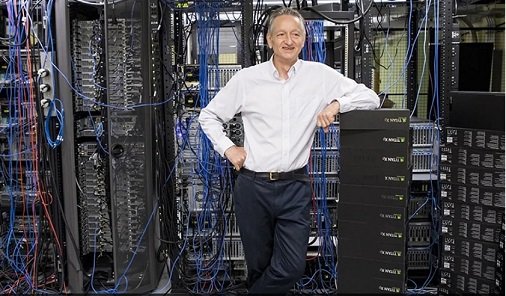Early Life and Education
Geoffrey Hinton was born on December 6, 1947, in Wimbledon, London, England. From a young age, Hinton exhibited a keen interest in science and mathematics, influenced by his mother, who was a psychologist, and his father, who was a physicist. He attended King’s College, Cambridge, where he earned a Bachelor of Arts degree in Experimental Psychology in 1970. His fascination with the brain and cognition led him to pursue further studies in artificial intelligence.
Hinton moved to the United States for his PhD at the University of Edinburgh, where he focused on artificial intelligence and cognitive psychology. He completed his doctorate in 1978, with a thesis titled “Parallel Models of Associative Memory,” which laid the groundwork for his future research in neural networks.
Career Beginnings
After completing his PhD, Hinton held various academic positions, including a postdoctoral fellowship at the University of Sussex. He returned to Canada in the early 1980s and took up a position at the University of Toronto. It was during this period that Hinton began to explore the potential of neural networks, a concept that had been largely overlooked in the AI community at the time.
In 1986, Hinton, along with David Rumelhart and Ronald J. Williams, published a groundbreaking paper titled “Learning Representations by Back-Propagating Errors.” This work introduced the backpropagation algorithm, which revolutionized the training of neural networks and is now fundamental to deep learning.
The Rise of Neural Networks
Despite the promising beginnings of neural networks in the 1980s, interest waned during the 1990s, a period often referred to as the “AI winter.” Funding and research into neural networks decreased significantly, leading many in the field to pivot to alternative approaches. Hinton, however, remained committed to exploring the potential of neural networks.
In the late 2000s, a resurgence of interest in deep learning began, driven by advancements in computing power, the availability of large datasets, and new techniques for training deeper networks. Hinton’s work during this period was instrumental in revitalizing the field. In 2006, he and his colleagues published a paper titled “Reducing the Dimensionality of Data with Neural Networks,” which introduced deep belief networks and demonstrated the effectiveness of unsupervised pre-training.
Breakthroughs and Achievements
Hinton’s contributions to deep learning garnered significant attention, particularly in the fields of computer vision and natural language processing. In 2012, he and his students developed a deep convolutional neural network known as AlexNet, which achieved a stunning performance in the ImageNet Large Scale Visual Recognition Challenge. AlexNet outperformed its competitors by a large margin, showcasing the power of deep learning and neural networks in image classification tasks.
This success marked a turning point for AI, leading to widespread adoption of deep learning techniques in various applications, from image and speech recognition to natural language processing. Hinton’s work paved the way for many advancements in AI, influencing both academia and industry.
In recognition of his groundbreaking contributions, Hinton received numerous accolades throughout his career. He was elected a Fellow of the Royal Society in 2013, one of the highest honors for a scientist in the UK. He also received the Turing Award in 2018, often regarded as the “Nobel Prize of Computing,” alongside Yann LeCun and Yoshua Bengio, for their work in deep learning.
Later Career and Current Endeavors
In addition to his academic pursuits, Hinton has been involved with various tech companies. He joined Google in 2013 as a part of their research team, where he applied his expertise in deep learning to enhance AI technologies. His work at Google has focused on areas such as neural network efficiency, reinforcement learning, and machine learning applications.
Hinton has also played a significant role in educating the next generation of AI researchers. He has supervised many PhD students who have gone on to make their own significant contributions to the field. His commitment to education extends to online platforms, where he has shared his knowledge through courses and lectures, making AI more accessible to a broader audience.
Philosophical Insights and Future Outlook
Throughout his career, Hinton has been vocal about the implications of AI and the ethical considerations surrounding its development. He has expressed concerns about the potential risks associated with advanced AI systems, emphasizing the need for responsible research and development. Hinton believes that as AI systems become more powerful, society must grapple with questions of control, safety, and ethical use.
In recent years, Hinton has also discussed the importance of understanding the human brain to inspire further advancements in AI. He argues that insights from neuroscience can guide the development of more efficient and effective AI systems, bridging the gap between biological and artificial intelligence.
Legacy and Impact
Geoffrey Hinton’s contributions to the field of artificial intelligence are immeasurable. He has been a driving force behind the resurgence of neural networks and deep learning, which have transformed numerous industries and applications. His pioneering research has not only advanced scientific understanding but has also influenced practical implementations of AI technology.
Hinton’s legacy is evident in the myriad of applications powered by deep learning, including self-driving cars, voice assistants, medical diagnosis tools, and more. His work has inspired countless researchers and practitioners in the field, fostering an environment of innovation and exploration.
As AI continues to evolve, Hinton’s influence will remain a guiding force in shaping the future of the field. His commitment to research, education, and ethical considerations ensures that his impact will be felt for generations to come.
Conclusion
Geoffrey Hinton stands as a towering figure in the realm of artificial intelligence, recognized for his foundational work in neural networks and deep learning. His journey from a curious young student to a leading researcher and advocate for responsible AI exemplifies the power of perseverance and innovation. As the world continues to navigate the complexities and possibilities of AI, Hinton’s contributions will serve as a cornerstone for future advancements and discussions in the field.
